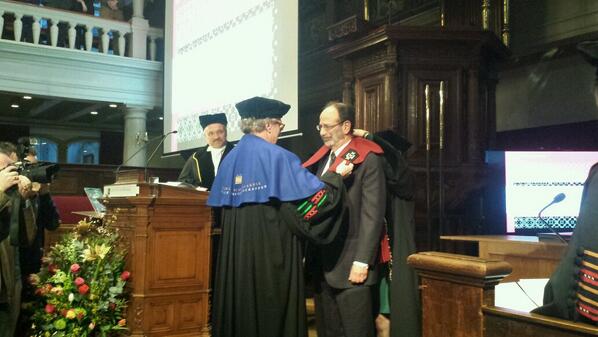Ido Erev and I will be presenting a paper on learning and choice behavior at one of the Sackler Colloquia run by the National Academy of Sciences:
Overview
III. Special Sciences
IV. Applications
In the Light of Evolution VIII: Darwinian Thinking in the Social Sciences
Organized by Brian Skyrms, John C. Avise and Francisco J. Ayala
January 10-11, 2014 at the Arnold and Mabel Beckman Center in Irvine, CA.
Overview
Darwinian thinking is now having a major impact in social science, both in the consideration of the consequences of biological and cultural evolution on traditional questions, and in the use of quasi-Darwinian adaptive dynamics in evolutionary game theory. This Darwinian point of view is having a major impact on economics, political science, sociology, anthropology, and demography.
Agenda
I. Evolution of Social Norms
Bargaining and Fairness, Kenneth Binmore, University College London
Cooperation, Natalia Komarova, University of California, Irvine
Friendship and Natural Selection, James H. Fowler, University of California, San Diego
Reputation and Punishment, Michihiro Kandori, University of Tokyo
II. Social Dynamics
Cooperation, Natalia Komarova, University of California, Irvine
Friendship and Natural Selection, James H. Fowler, University of California, San Diego
Reputation and Punishment, Michihiro Kandori, University of Tokyo
II. Social Dynamics
The Replicator Equation and Other Game Dynamics, Ross Cressman, Wilfrid Laurier University
Payoff-Based Learning Dynamics, Alvin Roth, Harvard University
Strategic Learning Dynamics, David K. Levine, Washington University
Cultural Evolution, Marcus W. Feldman, Stanford University
Payoff-Based Learning Dynamics, Alvin Roth, Harvard University
Strategic Learning Dynamics, David K. Levine, Washington University
Cultural Evolution, Marcus W. Feldman, Stanford University
Keynote Address: Public Goods: Competition, Cooperation, and Spite, Simon A. Levin, Princeton University
III. Special Sciences
Evolutionary Demography, Kenneth W. Wachter, University of California, Berkeley
Folklore of the Elite and Biological Evolution, Barry O’Neill, University of California, Los Angeles
Economics, Ted Bergstrom, University of California, Santa Barbara
Psychology, Dale Purves, Duke-National University of Singapore Graduate Medical School
Folklore of the Elite and Biological Evolution, Barry O’Neill, University of California, Los Angeles
Economics, Ted Bergstrom, University of California, Santa Barbara
Psychology, Dale Purves, Duke-National University of Singapore Graduate Medical School
IV. Applications
Evolutionary Implementation in Mechanism Design, Éva Tardos, Cornell University
Some Dynamics of Signaling, Brian Skyrms, University of California, Irvine
The Rate of Innovation Diffusion in Social Networks, H. Peyton Young, Oxford University
Homophily, Culture, and Coordinating Behaviors, Matthew O. Jackson, Stanford University
Some Dynamics of Signaling, Brian Skyrms, University of California, Irvine
The Rate of Innovation Diffusion in Social Networks, H. Peyton Young, Oxford University
Homophily, Culture, and Coordinating Behaviors, Matthew O. Jackson, Stanford University







